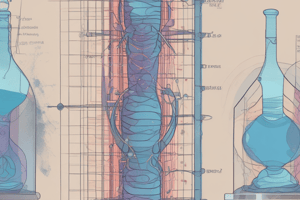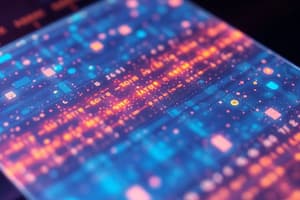Podcast
Questions and Answers
What is the primary role of 2-mercaptoethanol in the SDS-PAGE process?
What is the primary role of 2-mercaptoethanol in the SDS-PAGE process?
- To enhance protein color during staining
- To stabilize protein structures
- To increase the migration speed of proteins
- To reduce disulfide bonds and unfold proteins (correct)
In SDS-PAGE, what is the composition of the loading buffer?
In SDS-PAGE, what is the composition of the loading buffer?
- Glycine, water, and bromophenol blue
- SDS, Tris, and water
- Tris-HCl, SDS, glycerol, beta-mercaptoethanol, bromophenol blue (correct)
- Tris-HCl, SDS, and glycine
How do proteins migrate during SDS-PAGE?
How do proteins migrate during SDS-PAGE?
- Based on their shape and color
- Based on their molecular charge only
- Based on their molecular weight and charge
- Based on their size, moving from negative to positive pole (correct)
Which of the following components is found in the running buffer for SDS-PAGE?
Which of the following components is found in the running buffer for SDS-PAGE?
What is the purpose of the stacking gel in SDS-PAGE?
What is the purpose of the stacking gel in SDS-PAGE?
What determines the migration distance of the protein bands in SDS-PAGE?
What determines the migration distance of the protein bands in SDS-PAGE?
Which step follows the loading of samples into the SDS-PAGE gel?
Which step follows the loading of samples into the SDS-PAGE gel?
Which statement about the relationship between Rf value and protein size is correct?
Which statement about the relationship between Rf value and protein size is correct?
What is the primary mechanism by which SDS-PAGE separates proteins?
What is the primary mechanism by which SDS-PAGE separates proteins?
Which component of the polyacrylamide gel acts as a cross-linking agent?
Which component of the polyacrylamide gel acts as a cross-linking agent?
When the pore size of the polyacrylamide gel increases, what is the effect on protein migration rate?
When the pore size of the polyacrylamide gel increases, what is the effect on protein migration rate?
Which step is performed first in a two-dimensional gel electrophoresis?
Which step is performed first in a two-dimensional gel electrophoresis?
What role does sodium dodecyl sulfate (SDS) play in the SDS-PAGE process?
What role does sodium dodecyl sulfate (SDS) play in the SDS-PAGE process?
What does the variable %T represent in the context of polyacrylamide gels?
What does the variable %T represent in the context of polyacrylamide gels?
Which of the following components is NOT involved in the polymerization of polyacrylamide gel?
Which of the following components is NOT involved in the polymerization of polyacrylamide gel?
Which parameter affects the pore size of the polyacrylamide gel according to %C?
Which parameter affects the pore size of the polyacrylamide gel according to %C?
what are the components of polyacrylamide gel?
what are the components of polyacrylamide gel?
what is polyacrylamide gel
what is polyacrylamide gel
SDS facts
SDS facts
stacking gel:
stacking gel:
Separating (a.k.a. resolving) gel:
Separating (a.k.a. resolving) gel:
Loading (a.k.a. dissociation) buffer:
Loading (a.k.a. dissociation) buffer:
Running buffer:
Running buffer:
Rf=
Rf=
kDa
kDa
%T and %C
%T and %C
%T
%T
components of polyacrylamide gel:
components of polyacrylamide gel:
Flashcards
SDS-PAGE (SDS-polyacrylamide gel electrophoresis)
SDS-PAGE (SDS-polyacrylamide gel electrophoresis)
A technique used to separate proteins based on their size.
Protein Gel Electrophoresis
Protein Gel Electrophoresis
A method to separate proteins using an electric field and a gel.
Native Gel (a type of protein gel electrophoresis)
Native Gel (a type of protein gel electrophoresis)
Protein separation based on size, charge, and shape of the protein.
SDS
SDS
Signup and view all the flashcards
Polyacrylamide Gel
Polyacrylamide Gel
Signup and view all the flashcards
Acrylamide
Acrylamide
Signup and view all the flashcards
Isoelectric Focusing
Isoelectric Focusing
Signup and view all the flashcards
2-Dimensional Gel
2-Dimensional Gel
Signup and view all the flashcards
SDS-PAGE
SDS-PAGE
Signup and view all the flashcards
2-mercaptoethanol
2-mercaptoethanol
Signup and view all the flashcards
Separating Gel
Separating Gel
Signup and view all the flashcards
Loading Buffer
Loading Buffer
Signup and view all the flashcards
Rf Value
Rf Value
Signup and view all the flashcards
Standard Curve
Standard Curve
Signup and view all the flashcards
Stacking Gel
Stacking Gel
Signup and view all the flashcards
Running Buffer
Running Buffer
Signup and view all the flashcards
Study Notes
BIOL 3120 - Cell Biology Lab - Lab 5: SDS-Polyacrylamide Gel Electrophoresis (SDS-PAGE)
- Lab Objective: Protein separation using SDS-PAGE
- Types of Protein Gel Electrophoresis:
- Native gel: separation based on size, charge, and shape
- Isoelectric focusing: separation based on isoelectric point
- SDS-PAGE: separation based on size (focus of this lab)
- 2-dimensional gel: two-step process, first step based on isoelectric point (isoelectric focusing), second step separation is size based through SDS-PAGE
- Components of Polyacrylamide Gel:
- Acrylamide: matrix material
- N,N'-methylene-bis-acrylamide ("Bis"): cross-linking agent
- TEMED: catalyst
- Ammonium persulfate: initiator
- Gel formation: polymerization of acrylamide and bis creates a network of pores
- Pore size (%T): determines protein migration rate; decreases with increased %T.
- %T: total percentage of acrylamide (monomer) and bis-acrylamide (cross-linker) per 100 ml of solution.
- %C: percentage (weight) of crosslinker to acrylamide and cross-linker (weight ratio)
- SDS-PAGE Procedure
- Set up precast gel (following video instructions)
- Mix 5µL protein sample with 5µL loading buffer
- Heat the sample at 95-100°C for 5 min.
- Load sample into well(s).
- Run the gel at 150V until dye front reaches the bottom.
- Stain the gel with Coomassie (CBB) stain solution
- Destain the gel with 100mL destain solution.
- SDS-PAGE Components:
- Stacking gel: top of gel, lower %T, larger pore size, lower pH; all proteins line up and enter separating gel at same time.
- Separating gel: lower %T, smaller pore size, higher pH; proteins separate based on size.
- Loading buffer: Tris-HCl, SDS, glycerol, β-mercaptoethanol, bromophenol blue
- Running buffer: Tris, glycine, SDS, pH 8.3.
- Protein Migration (Rf):
- Migration distance of protein from origin (bottom of well) to dye front.
- Standard curves: plot log10 molecular weight vs. Rf for protein markers to determine bands size for unknown protein bands.
Post-Lab Questions and Requirements
- Calculating band size: use standard curve of known molecular weight to determine unknown bands size.
- use Rf values for unknown bands in standard curve to determine molecular weight.
- Lab Report Requirements (Lab 5):
- Introduction: SDS-PAGE and protein electrophoresis.
- Materials: list chemicals used and instrument.
- Methods: experimental procedure steps
- Results: protein gel analysis (figure)
- Discussion/Conclusion: improvements, result justification, conclusions.
- File name: BIOL3120_Section_LastName_FirstName_LabN; email lab report to provided email address.
Studying That Suits You
Use AI to generate personalized quizzes and flashcards to suit your learning preferences.




